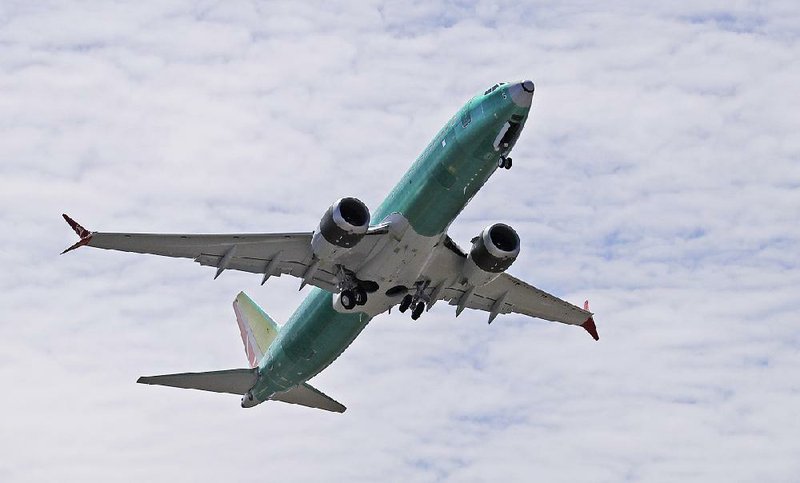A high-ranking Boeing Co. pilot working on the 737 Max expressed misgivings three years ago during its certification about a feature since implicated in two fatal crashes, calling its handling performance "egregious," according to 2016 instant messages.
The Federal Aviation Administration said Boeing alerted the U.S. Transportation Department late Thursday of instant messages between two employees of the plane-maker, the FAA said Friday. The U.S. regulator said Boeing Co. was aware of the communication for months.
"The FAA finds the substance of the document concerning," the agency said in a statement. "The FAA is also disappointed that Boeing did not bring this document to our attention immediately upon its discovery."
The November 2016 instant messages, which were reviewed by Bloomberg News, were exchanges between between Mark Forkner, then Boeing's chief technical pilot for the 737, and another 737 technical pilot, Patrik Gustavsson.
In the messages, Forkner described his alarm at simulator tests in which he encountered troubling behavior of the automated flight control system implicated in the two fatal crashes.
Boeing had earlier assured the aviation regulator that the feature known as the maneuvering characteristics augmentation system was benign and didn't need to be included in the plane's flight manuals, according to a person familiar with the issue.
Forkner told Gustavsson that the system was "running rampant in the sim on me," referring to simulator tests of the aircraft.
Forkner expressed concern that he may have unknowingly misled the FAA. "So I basically lied to the regulators (unknowingly)," he wrote.
The maneuvering characteristics augmentation system automatically pushes down the plane's nose if it senses it's in danger of an aerodynamic stall. Malfunctions of the system have been blamed for a pair of fatal crashes over the past year, resulting in the worldwide grounding of Boeing's best-selling jet in March.
"I'm levelling [sic] off at like 4,000 ft, 230 knots and the plane is trimming itself like craxy [sic]," Forkner wrote. "I'm like, WHAT?"
The agency said it was turning over the documents to congressional investigators.
FAA Administrator Steve Dickson sent a terse letter to Boeing Chief Executive Officer Dennis Muilenburg on Friday demanding more information.
"I understand that Boeing discovered the document in its files months ago," Dickson said. "I expect your explanation immediately regarding the content of this document and Boeing's delay in disclosing the document to its safety regulator."
"Over the past several months, Boeing has been voluntarily cooperating with the House Transportation & Infrastructure Committee's investigation into the 737 Max," company spokesman Gordon Johndroe said in an email.
"As part of that cooperation, today we brought to the committee's attention a document containing statements by a former Boeing employee. We will continue to cooperate with the Committee as it continues its investigation. And we will continue to follow the direction of the FAA and other global regulators, as we work to safely return the 737 Max to service," Johndroe said.
The communications between the pilots suggest the maneuvering characteristics augmentation system was performing in simulator tests in ways they hadn't expected.
After Forkner said he was concerned about misleading regulators, Gustavsson replied that "it wasn't a lie, no one told us that was the case."
"I don't know, the test pilots have kept us out of the loop," Gustavsson said.
Forkner replied, "they're all so d*** busy, and getting pressure from the program."
The Senate Commerce Committee is completing preparations for a hearing about Boeing this month, and members expect to use it to interview Muilenburg about the crashes and grounding of the 737 Max, according to four people familiar with the matter.
Muilenburg is already scheduled to appear before the House Transportation and Infrastructure Committee on Oct. 30. The Senate hearing is expected to take place Oct. 29 or after the House committee hearing, according to the people, who spoke on the condition of anonymity because the hearing had not yet been confirmed.
The occasion will be the first time Boeing executives address Congress about the two crashes, as frustration with the company mounts on Capitol Hill and throughout the aviation industry. John Hamilton, the chief engineer of Boeing's commercial airplanes division, is also expected to testify at the House hearing and may also appear at the Senate hearing.
The hearings come on the heels of the removal of Muilenburg's title as chairman of the Boeing board last week. They are expected to cover everything from the design, certification and marketing of the 737 Max to what happened on the flights that crashed.
Last week, a multiagency task force released a report that faulted both Boeing and the FAA for their work on the plane. It argued that Boeing had not been forthcoming enough about the maneuvering characteristics augmentation system, and that the FAA had been unequipped to effectively review the plane.
This month, it was revealed that a Boeing engineer who worked on the Max filed an internal ethics complaint alleging that the company, in order to minimize costs, rejected a proposed safety system that he felt could have reduced the risks that contributed to the crashes.
As a result of the prolonged grounding, airlines around the world have canceled thousands of flights and lost hundreds of millions of dollars. Boeing has announced that the grounding will cost the company at least $8 billion.
Information for this article was contributed by Alan Levin, Ryan Beene and Julie Johnsson of Bloomberg News and by David Gelles of The New York Times.
Business on 10/19/2019
